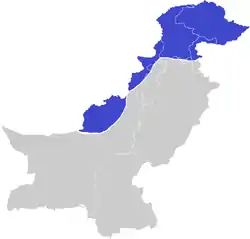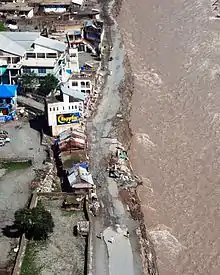Climate of Pakistan
Pakistan's climate is a continental type of climate, characterized by extreme variations in temperature, both seasonally and daily, because it is located on a great landmass north of the Tropic of Cancer (between latitudes 25° and 36° N).

Very high altitudes modify the climate in the cold, snow-covered northern mountains; temperatures on the Balochistan plateau are somewhat higher. Along the coastal strip, the climate is modified by sea breeze. In the rest of the country, temperatures reach great heights in the summer; the mean temperature during June is 38 °C (100 °F) in the plains, the highest temperatures can exceed 47 °C (117 °F). During summer, hot winds called Loo blow across the plains during the day. Trees shed their leaves to avoid loss of moisture. Pakistan recorded one of the highest temperatures in the world, 53.7 °C (128.66 °F) on 28 May 2017, the hottest temperature ever recorded in Pakistan and also the second hottest measured temperature ever recorded in Asia.[1]
The dry, hot weather is broken occasionally by dust storms and thunderstorms that temporarily lower the temperature. Evenings are cool; the daily variation in temperature may be as much as 11 °C to 17 °C. Winters are cold, with minimum mean temperatures in Punjab of about 4 °C (39 °F) in January, and sub-zero temperatures in the far north and Balochistan.
Climate geography

The monsoon and the Western Disturbance are the two main factors which alter the weather over Pakistan; Continental air prevails for rest of the year. Following are the main factors that influence the weather over Pakistan.
- Western Disturbances mostly occur during the winter months and cause light to moderate showers in southern parts of the country while moderate to heavy showers with heavy snowfall in the northern parts of the country. These westerly waves are robbed of most of the moisture by the time they reach Pakistan.
- Fog occurs during the winter season and remains for weeks in upper Sindh, central Khyber Pakhtunkhwa and Punjab.
- Southwest Monsoon occurs in summer from the month of June till September in almost whole Pakistan excluding western Balochistan, FATA, Chitral and Gilgit–Baltistan. Monsoon rains bring much awaited relief from the scorching summer heat. These monsoon rains are quite heavy by nature and can cause significant flooding, even severe flooding if they interact with westerly waves in the upper parts of the country.
- Tropical Storms usually form during the summer months from late April till June and then from late September till November. They affect the coastal localities of the country.
- Dust storms occur during summer months with peak in May and June, They are locally known as Andhi. These dust storms are quite violent. Dust storms during the early summer indicate the arrival of the monsoons while dust storms in the autumn indicate the arrival of winter.
- Heat waves occur during May and June, especially in southern Punjab, central Balochistan and Sindh.
- Thunderstorms most commonly occur in northern Punjab, Khyber Pakhtunkhwa and Azad Kashmir.
- Continental air prevails during the period when there is no precipitation in the country.
Pakistan has four seasons: a cool, dry winter from December through February; a hot, dry spring from March through May; the summer rainy season, or southwest monsoon period, from June through September; and the retreating monsoon period of October and November. The onset and duration of these seasons vary somewhat according to location.
The climate in the capital city of Islamabad varies from an average daily low of 2 °C in January to an average daily high of 38 °C in June. Half of the annual rainfall occurs in July and August, averaging about 255 millimeters in each of those two months. The remainder of the year has significantly less rain, amounting to about fifty millimeters per month. Hailstorms are common in the spring.
Pakistan's largest city, Karachi, which is also the country's industrial center, is more humid than Islamabad but gets less rain. Only July and August average more than twenty-five millimeters of rain in the Karachi area; the remaining months are exceedingly dry. The temperature is also more uniform in Karachi than in Islamabad, ranging from an average daily low of 13 °C during winter evenings to an average daily high of 34 °C on summer days. Although the summer temperatures do not get as high as those in Punjab, the high humidity causes the residents a great deal of discomfort. In Islamabad, there are cold winds from the north of Pakistan.[2]
Extreme weather events
Highest temperature and rainfall ever recorded
The weather extremes in Pakistan include high and low temperatures, heavy rainfall and flooding. The highest temperature ever recorded in Pakistan is 53.7 °C (128.66 °F), in Turbat, Balochistan on 28 May 2017. It was not only the hottest temperature ever recorded in Pakistan but also the second verified hottest temperature ever recorded in Asia [1] and the fourth highest temperature ever recorded on earth. The highest rainfall of 620 millimetres (24 in) was recorded in Islamabad during 24 hours on 24 July 2001. The record-breaking rain fell in just 10 hours. It was the heaviest rainfall in Islamabad in the previous 100 years.
Tropical cyclones and tornadoes
Each year before the onset of monsoon that is 15 April to 15 July and also after its withdrawal that is 15 September to 15 December, there is always a distinct possibility of the cyclonic storm to develop in the north Arabian Sea. Cyclones form in the Arabian sea often results in strong winds and heavy rainfall in Pakistan's coastal areas. However tornadoes mostly occur during spring season that is March and April usually when a Western Disturbance starts effecting the northern parts of the country. It is also speculated that cycles of tornado years may be correlated to the periods of reduced tropical cyclone activity.
Drought
The drought has become a frequent phenomenon in the country. Already, the massive droughts of 1998-2002 has stretched the coping abilities of the existing systems to the limit and it has barely been able to check the situation from becoming a catastrophe. The drought of 1998-2002 is considered the worst drought in 50 years. According to the Economic Survey of Pakistan, the drought was one of the most significant factors responsible for the less than anticipated growth performance. The survey terms it as the worst drought in the history of the country. According to the government, 40 percent of the country's water needs went unmet.[3][4]
Floods
Pakistan has seen many floods, the worst and most destructive is the recent 2010 Pakistan floods, other floods which caused destruction in the history of Pakistan, include the flood of 1950, which killed 2910 people; on 1 July 1977 heavy rains and flooding in Karachi, killed 248 people, according to Pakistan meteorological department 207 millimetres (8.1 in) of rain fell in 24 hours.[5] In 1992 flooding during Monsoon season killed 1,834 people across the country, in 1993 flooding during Monsoon rains killed 3,084 people, in 2003 Sindh province was badly affected due to monsoon rains causing damages in billions, killed 178 people, while in 2007 Cyclone Yemyin submerged lower part of Balochistan Province in sea water killing 380 people. Before that it killed 213 people in Karachi on its way to Balochistan.
2010 Floods
2010 July floods swept 20% of Pakistan's land, the flood is the result of unprecedented Monsoon rains which lasted from 28 July to 31 July 2010. Khyber Pakhtunkhwa and North eastern Punjab were badly affected during the monsoon rains when dams, rivers and lakes overflowed. By mid-August, according to the governmental Federal Flood Commission (FFC), the floods had caused the deaths of at least 1,540 people, while 2,088 people had received injuries, 557,226 houses had been destroyed, and over 6 million people had been displaced.[6] One month later, the data had been updated to reveal 1,781 deaths, 2,966 people with injuries, and more than 1.89 million homes destroyed.[7] The flood affected more than 20 million people exceeding the combined total of individuals affected by the 2004 Indian Ocean tsunami, the 2005 Kashmir earthquake and the 2010 Haiti earthquake.[8][9] The flood is considered as worst in Pakistan's history affecting people of all four provinces and Gilgit–Baltistan and Azad Kashmir region of Pakistan.[10]
2011 Sindh floods
The 2011 Sindh floods began during the monsoon season in mid-August 2011, resulting from heavy monsoon rains in Sindh, Eastern Balochistan, and Southern Punjab.[11] The floods have caused considerable damage; an estimated 270 civilians have been killed, with 5.3 million people and 1.2 million homes affected.[12] Sindh is a fertile region and often called the "breadbasket" of the country; the damage and toll of the floods on the local agrarian economy is said to be extensive. At least 1.7 million acres of arable land has been inundated as a result of the flooding.[12] The flooding has been described as the worst since the 2010 Pakistan floods, which devastated the entire country.[12] Unprecedented torrential monsoon rains caused severe flooding in 16 districts of Sindh province.[13]
Extreme temperatures
| Climate data for Pakistan | |||||||||||||
|---|---|---|---|---|---|---|---|---|---|---|---|---|---|
| Month | Jan | Feb | Mar | Apr | May | Jun | Jul | Aug | Sep | Oct | Nov | Dec | Year |
| Record high °C (°F) | 35.9 (96.6) |
39.1 (102.4) |
45.5 (113.9) |
50.2 (122.4) |
53.5 (128.3) |
52.8 (127.0) |
52.2 (126.0) |
48.9 (120.0) |
46.1 (115.0) |
44.0 (111.2) |
41.0 (105.8) |
35 (95) |
53.5 (128.3) |
| Record low °C (°F) | −25.1 (−13.2) |
−34.0 (−29.2) |
−13.5 (7.7) |
−3.9 (25.0) |
−0.3 (31.5) |
4.0 (39.2) |
7.5 (45.5) |
3.3 (37.9) |
−0.6 (30.9) |
−8.3 (17.1) |
−13.3 (8.1) |
−22.8 (−9.0) |
−34.0 (−29.2) |
Climate change

Climate change in Pakistan is expected to cause wide-ranging effects on the environment and people in Pakistan. As a result of ongoing climate change, the climate of Pakistan has become increasingly volatile over the past several decades; this trend is expected to continue into the future. In addition to increased heat, drought and extreme weather conditions in some parts of the country, the melting of glaciers in the Himalayas threatens many of the most important rivers of Pakistan. Between 1999 and 2018, Pakistan was ranked the 5th worst affected country in terms of extreme climate caused by climate change.[14]
Pakistan contributes little to global greenhouse gas (GHG) emissions at about less than 1%,[15] yet it is very vulnerable to the effects of climate change. Pakistan's lower technical and financial capacity to adapt to the adverse impacts of climate change worsen its vulnerability.[16] Food and water security, as well as large displacement of populations are major threats faced by the country.[17] Pakistan's agriculture-dependent economy is especially susceptible to increasing irregularity and uncertainty over climatic conditions. Like many other South Asian nations, Pakistan is faced by high risk due to climate change effects.[18]See also
References
- "WMO verifies 3rd and 4th hottest temperature recorded on Earth". World Meteorological Organization. 18 June 2019. Retrieved 8 May 2020.
- "Pakistan - Climate". countrystudies.us. Retrieved 7 April 2018.
- "Archived copy" (PDF). Archived from the original (PDF) on 9 July 2011. Retrieved 1 June 2010.CS1 maint: archived copy as title (link)
- Platform, International Recovery. "Sorry, there has been a problem - 'assets/publication/9+sept/Drought/drought+coping+in+afghanistan.pdf' cannot be found - International Recovery Platform" (PDF). www.recoveryplatform.org. Retrieved 7 April 2018.
- "Dawn.com: Heavy Rain in Karachi". Dawn.com. Retrieved 6 September 2010.
- Ahmadani A (19 August 2010). "Heavily Funded FFC Fails to Deliver". TheNation. Archived from the original on 6 July 2011. Retrieved 17 October 2010.
- Singapore Red Cross (15 September 2010). "Pakistan Floods:The Deluge of Disaster - Facts & Figures as of 15 September 2010". Retrieved 18 October 2010.
- South Asia, BBC News (14 August 2010). "Floods affect 20m people – Pakistan PM Gilani". British Broadcasting Corporation. Retrieved 14 August 2010.
- "Floods in Pakistan worse than tsunami, Haiti". gulfnews. Retrieved 12 August 2010.
- "Dawn.com : 2010 Pakistan Floods". Dawn.com. Retrieved 6 September 2010.
- "Pakistan floods: Oxfam launches emergency aid response". BBC World News South Asia. 14 September 2011. Retrieved 15 September 2011.
- "Floods worsen, 270 killed: officials". The Express Tribune. 13 September 2011. Retrieved 13 September 2011.
- "Archived copy". Archived from the original on 24 April 2012. Retrieved 26 December 2010.CS1 maint: archived copy as title (link)
- Eckstein, David, et al. "Global climate risk index 2020." (PDF) Germanwatch (2019).
- "Pakistan crafts plan to cut carbon emissions 30% by 2025". The Express Tribune. 10 June 2015. Retrieved 10 June 2015.
- "Pakistan National Policy on Climate Change". Archived from the original on 5 March 2016. Retrieved 10 May 2015.
- Zaheer, Khadija; Colom, Anna. "Pakistan, How the people of Pakistan live with climate change and what communication can do" (PDF). www.bbc.co.uk/climateasia. BBC Media Action.
- Chaudhry, Qamar Uz Zaman (24 August 2017). Climate Change Profile of Pakistan. Asian Development Bank. doi:10.22617/tcs178761. ISBN 978-92-9257-721-6.
 Text was copied from this source, which is available under a Creative Commons Attribution 3.0 IGO (CC BY 3.0 IGO) license.
Text was copied from this source, which is available under a Creative Commons Attribution 3.0 IGO (CC BY 3.0 IGO) license.